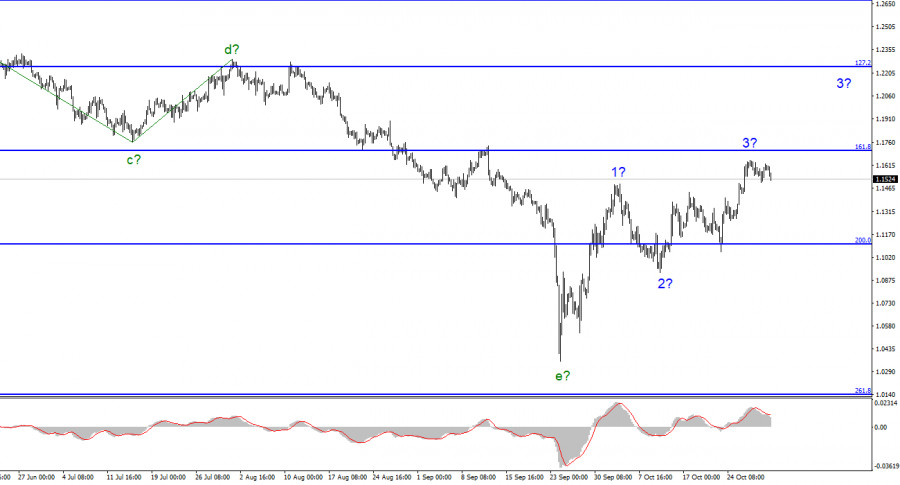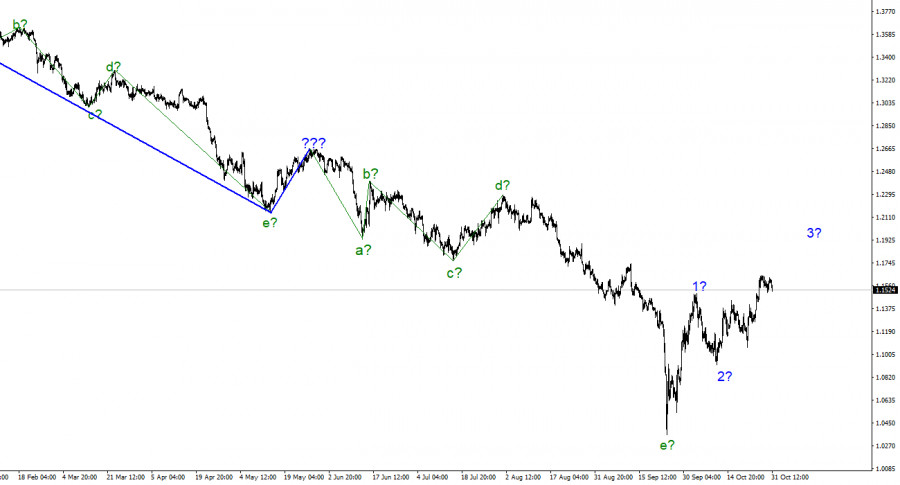

For the pound/dollar instrument, the wave marking looks quite complicated at the moment but still does not require any clarification. We have a supposedly completed downward trend segment consisting of five waves a-b-c-d-e. If this is indeed the case, then the construction of a new upward trend section has begun. Its first and second waves are presumably completed, and the third wave is being built, which can be both 3 and C. Since the European wave marking has changed, both wave markings now coincide. As I have already said, the upward structure can be limited to only three waves. In this case, the completion of the third wave may occur at any time, after which the construction of a new downward trend section may begin since the peak of this wave is already above the peak of the first wave. And if this wave is c, and not 3, then it should not be extended. Only a small approach above the last peak, which already exists, is enough. We managed to sort out the wave markings, they have recently left many questions unanswered, but there are still huge doubts that the demand for the British will grow for a long time now. The instrument retains the possibility of resuming a downward trend segment.
The exchange rate of the Pound/Dollar instrument decreased by 90 basis points on October 31, and the market does not shine with activity today. The instrument has begun to move away from the peaks reached earlier, but so far, this departure is too weak to talk about the completion of the third wave. This wave may take on a more extended form, or it may end today. In this case, it will be identified as wave c, and the entire upward section of the trend will take a pronounced corrective form. Well, in the same case, we are waiting for the construction of a new downward trend section.
I do not undertake to predict how the auction will take place this week. Although I believe that the Bank of England and the Fed will raise their rates by 75 basis points, it is unknown how the market will react to two such important events. I want to remind you that we are still waiting for a report on unemployment and payrolls, which is also very important. Thus, solely based on the wave marking, there is a probability of a decrease in demand for the British since the third wave is not as strong and fast as the first. It can be seen that demand is slowly starting to decline. However, nothing prevents the British or American regulator from raising the rate not as much as the market expects. And as a result, we may not get the movements we can count on now. This week may be chaotic, but I still think that before the meetings of the Bank of England and the Fed, the market will increase demand for the dollar. This assumption is because the Fed can raise the rate as long as necessary, and the Bank of England is unlikely. In addition, inflation in the UK is higher than in the US, which means that Britain needs a stronger tightening of monetary policy.

The wave pattern of the Pound/Dollar instrument assumes the construction of a new upward trend segment. Thus, now I advise buying the instrument on the MACD reversals "up" with targets near the estimated mark of 1,1705, which equates to 161.8% Fibonacci. You should buy cautiously, as the trend's downward section may resume construction.
The picture is very similar to the Euro/Dollar instrument at the higher wave scale. The same ascending wave does not fit the current wave pattern, the same five waves down after it. The downward section of the trend can turn out to be almost any length, but it may already be completed.